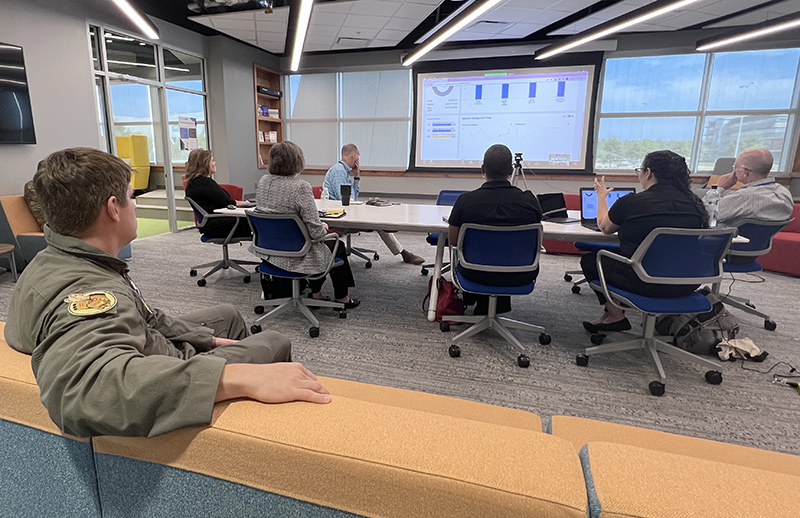AFGSC Office of the Chief Scientist received a demonstration of the Aircrew Auto Diagnostic Adaptive Precision Training (AirADAPT) Aug. 30 at STRIKEWERX in the Cyber Innovation Center, Bossier City, Louisiana. (Sean Green/STRIKEWERX)
By Sean Green | STRIKEWERX Marketing and Communication Director
BOSSIER CITY, La. — Air Force Global Strike Command and STRIKEWERX are exploring new technology solutions to enhance training for aircrews.
AFGSC Office of the Chief Scientist received a demonstration of the Aircrew Auto Diagnostic Adaptive Precision Training (AirADAPT) at STRIKEWERX Aug. 30. AirADAPT generates a comprehensive, assessment of aircrew training performance for AFGSC instructors to provide Airmen with essential skills in an efficient manner.
“Our overall goal is to improve training by using the science of human factors and a data-driven approach to reduce training time while improving retention,” said AFGSC Chief Scientist Dr. Donna Senft. “AirADAPT is one of several technology avenues our office is pursuing to help bomber aircrews improve proficiency with air refueling by supporting consistent and standardized assessment, reducing bias from and demand on instructors, and increasing capacity for performance tracking.”
AirADAPT, which is a performance analytics adaptive instruction engine, integrates data from multiple sources for adaptations during and following training. It creates a large-scale, integrated network of simulation tools to support collaborative training across individuals, crews, or units.
“AirADAPT extends technologies from previous STRIKEWERX Challenges — the B-52 Air Refueling Trainer and Advanced Training Concepts,” said Russ Mathers, STRIKEWERX director. “It will accomplish this by providing effective and robust performance analytics that can propel personalized and adaptive instruction.”
Design Interactive, of Orlando, Florida, utilized AirADAPT to provide a comprehensive assessment of aircrew training performance. That software also applies a computational model for adapting training scenarios.
Audrey Zlatkin, Design Interactive project manager, demonstrated the platform’s ability to provide a snapshot of the Airman’s overall performance, produce performance graphs for instructors, identify problem areas in training, and create links from data to video of performance for instructors to observe training sessions.
“The goal is to provide tools to automate and take burden off the instructor and shorten the learning curve,” Zlatkin said.
Maj. Brandon Wolf, AirADAPT project champion, noted that training methods have not changed and AirADAPT will allow training to be viewed in a whole new way.
“In the past, training was mostly observed in a subjective way with analysis left to the instructor, and this allows an objective view and deeper level of analysis with standardization across the board,” said Wolf.
AirADAPT will now be integrated into virtual training at Barksdale AFB, Louisiana, and Minot AFB, North Dakota, for further feedback and revisions.


